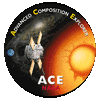
ACE Scientific Goals
The observations from ACE instruments allow the investigation of a
wide range of fundamental problems in the following major areas:
- The Elemental and Isotopic Composition of Matter
A major objective is the accurate and comprehensive determination of the
elemental and isotopic composition of the various samples of "source
material" from which nuclei are accelerated. Thus, ACE measurements
will:
- Generate a set of solar isotopic abundances based on
direct sampling of solar material.
- Determine the coronal elemental and isotopic composition with
greatly improved accuracy.
- Establish the pattern of isotopic differences between galactic cosmic
ray and solar system matter.
- Measure the elemental and isotopic abundances of interstellar and
interplanetary "pick-up ions".
- Determine the isotopic composition of the "anomalous cosmic ray"
component thought to represent a sample of the very local interstellar
medium.
- Origin of the Elements and Subsequent Evolutionary Processing
Isotopic "anomalies" in meteorites indicate that the solar system was not
homogeneous when formed, while other data suggest that the solar
composition continues to evolve. Similarly, the galaxy is neither uniform
in space nor constant in time due to continuous stellar nucleosynthesis.
ACE measurements will:
- Search for additional differences between the isotopic composition
of solar and meteoritic material.
- Determine the contributions of solar-wind and solar flare nuclei to
lunar and meteoritic material, and to planetary atmospheres and
magnetospheres.
- Determine the dominant nucleosynthesic processes that contribute to
cosmic ray source material.
- Determine whether cosmic rays are a sample of freshly sythesized
material (e.g., from supernovae), or of the contemporary interstellar
medium.
- Search for isotopic patterns in solar and galactic material as a test
of galactic evolution models.
- Formation of the Solar Corona and Acceleration of the Solar
Wind
Solar energetic particles, solar wind, and spectroscopic observations show
that the elemental composition of the corona is differentiated
from that of the photosphere, although the processes by which this occurs,
and by which the solar wind is subsequently accelerated, are poorly
understood. The detailed composition and charge-state data provided by
ACE will:
- Isolate the dominant coronal formation processes by comparing a
broad range of coronal and photospheric abundances.
- Study plasma conditions at the source of the solar wind and the solar
energetic particles by measuring and comparing the charge states of these
two populations.
- Study solar wind acceleration processes and any charge or
mass-dependent fractionation in various types of solar wind flows.
- Particle Acceleration and Transport in Nature
Particle acceleration is ubiquitous in nature and is one of the
fundamental problems of space plasma astrophysics. The unique data set
that will be obtained by ACE measurements will:
- Make direct measurements of charge and/or mass-dependent
fractionation during solar flare and interplanetary acceleration.
- Constrain solar flare and interplanetary acceleration models with
charge, mass, and spectral data spanning up to five decades in energy.
- Test theoretical models for 3He-rich flares and solar gamma ray
events.
- Measure cosmic ray acceleration and propagation time scales using
radioactive "clocks".

Typical energy spectrum of energetic Oxygen-16 nuclei resulting from the
various particle populations that will be observed by ACE.
The solid
curves represent "steady-state" components, while the dotted curves are
for "transient" phenomena.
Also shown is a postulated quiet-time flux of
supra-thermal solar particles (dashed curve). The energy ranges of the
ACE instruments are indicated for resolution of isotopes (blank), elements
only (cross-hatched), and ionic charge-states (stipled). Other nuclear
species generally tend to have spectra that are similarly shaped to that
of oxygen (but of varying intensity) when plotted as a function of
energy/nucleon.
Author: Eric R. Christian - erc@cosmicra.gsfc.nasa.gov
Curators: ACE Science Center - asc@srl.caltech.edu
Last Updated: February 5, 2000
Return to Caltech ACE Home Page
